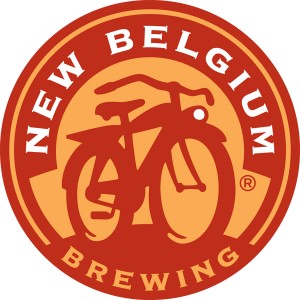
While Lauren Salazar was in Las Vegas for several of the New Belgium events in town, I was given a chance to sit down with her and discuss New Belgium’s creative process and some of their upcoming projects.
La Folie has become one of my favorite beers and being able to sit down and talk with the blender who makes La Folie was awesome. I’m really looking forward to all of the new beers that we discussed, as well as New Belgium’s expansion.
Hooked on Hops: You’re known for being the wood cellar manager at New Belgium and blending sour beers, like La Folie. What are some non-sour beers that you enjoy drinking?
Lauren Salazar: I’m a crazy stout fan! Anything dark, malty, huge; that’s my thing. Old Rasputin, Big Bad Baptist, I love anything huge and big. (more…)

New Belgium’s La Folie has become one of my favorite beers. The first time I had it, I didn’t know what to think. I could tell that this was an amazingly complex beer, but I wasn’t ready for the amount of sour that was coming my way. To me, it was like drinking vinegar. It wasn’t until I began drinking other lesser sour beers, and learning of how La Folie is made, that I began to understand, respect, and ultimately, enjoy this beer.
Lauren Salazar is the blender at New Belgium who creates La Folie. This Embrace the Funk interview with her is worth a read. In it, she describes the process that New Belgium goes through to create this beer. Some notable bits of info regarding La Folie:
– La Folie is a technically a lager. Before the base beer is acidified, it is fermented with a lager yeast strain, making it a dry as possible.
– Different oak fermentors of the base beer are continually being individually drained by different amounts to make different sour beers throughout the year. As a result of this, the beer that is being used to blend and create La Folie is already between one and four years old.
– Because La Folie is a blend of aged sour beers, Lauren doesn’t recommend aging the beer. In her mind, she already did the aging for you.
– La Folie is pasteurized, meaning that after it is blended, the beer is heated to kill all living bacteria in the beer. The idea behind this is that the beer is frozen in time in it’s ideal form.
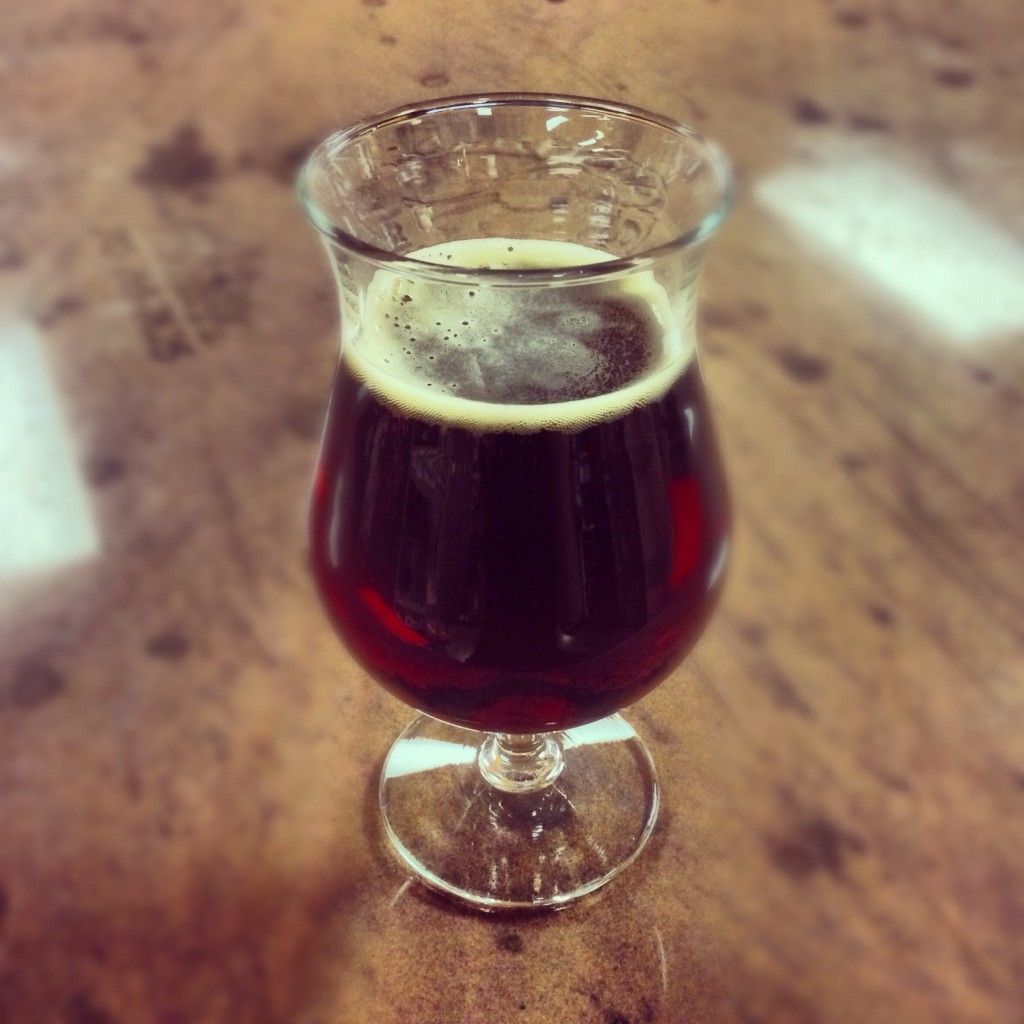
The next time I had a bottle of La Folie, it was an entirely different experience compared to the first time. I could taste the flavors of cherries, red wine vinegar, leather, oak, and green apples. It was like a sweet berry fruit dipped in a balsamic reduction. The bright, clear color was amazing to look at.
This past Wednesday, Khoury’s Fine Wine put a keg of La Folie on tap. Keg beers need to be kept a fairly cold temperature to balance the carbonation and to keep the beer from getting too foamy. If you order this beer on tap, be sure to let it sit for a few minutes to warm up. Wrapping your hands around the glass helps with this. If the beer is too cold, most of the flavor is hidden; as it warms it will start to open up.
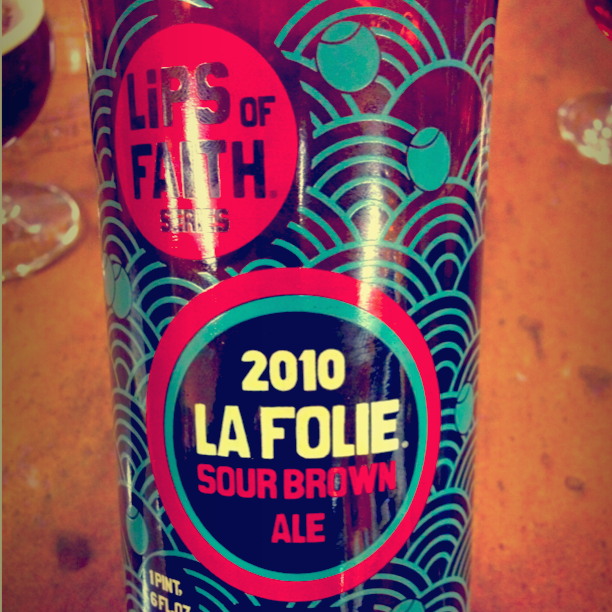
Despite Lauren’s advice, New Belgium was selling 2010 bottles of La Folie during GABF week. Danny picked up a bottle so we could compare it with the keg at Khoury’s. The beer had some of the obvious signs of oxidation in the aroma and aftertaste. However, rather than being a deterrent, it complimented the sourness of the beer. It seemed to reveal a more berry like flavor. The sourness was still very present, if not more so. Your own preferences will determine which one is better. Danny preferred the aged version. I liked the cleaner, fresher version. Regardless, both were delicious, and trying the two side by side was a great experience.
As much as I love this beer, it is difficult for me to recommend it. It truly is a one of a kind beer, and as such, is not for everyone. It really takes an open mind and a previous experience to sour beers to keep this from being an overpowering shock.
See also: The Science of Sour
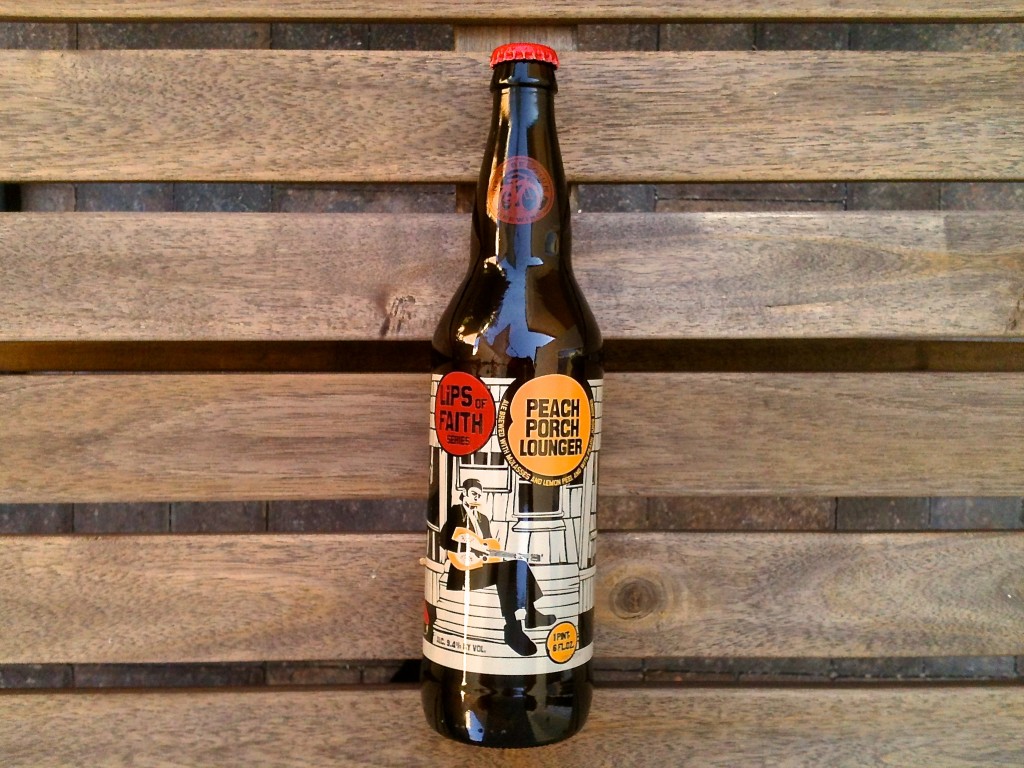 Over the past year, I’ve been very impressed with New Belgium’s Lips of Faith series of beers. The collaborations they’ve started making with other breweries has been fantastic. Last year’s Kick, made with Elysian Brewing from Seattle, is still one of the most unique, and flavorful takes on the fall pumpkin beer theme. This year’s Brett Beer, made with Lost Abbey from San Marcos, was an incredibly refreshing beer that should age very well. More recently, Super India Pale Ale, from New Belgium and The Alpine Beer Company, brought immense flavor and balance to the over saturated IPA market.
Over the past year, I’ve been very impressed with New Belgium’s Lips of Faith series of beers. The collaborations they’ve started making with other breweries has been fantastic. Last year’s Kick, made with Elysian Brewing from Seattle, is still one of the most unique, and flavorful takes on the fall pumpkin beer theme. This year’s Brett Beer, made with Lost Abbey from San Marcos, was an incredibly refreshing beer that should age very well. More recently, Super India Pale Ale, from New Belgium and The Alpine Beer Company, brought immense flavor and balance to the over saturated IPA market.
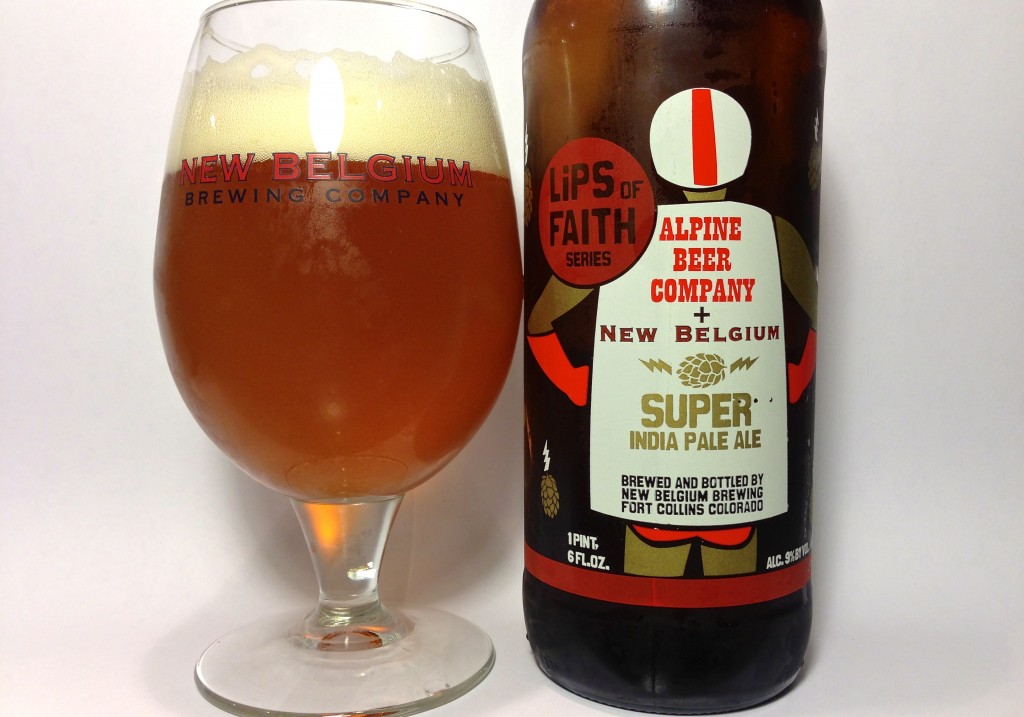 About a week ago, New Belgium released the last of it’s 2012 Lips of Faith beers. Bière De Garde is a collaboration beer made with Brewery Vivant from Michigan. I haven’t the chance to try this yet, but I’ve heard several people call this one of the best of New Belgium’s beers.
About a week ago, New Belgium released the last of it’s 2012 Lips of Faith beers. Bière De Garde is a collaboration beer made with Brewery Vivant from Michigan. I haven’t the chance to try this yet, but I’ve heard several people call this one of the best of New Belgium’s beers.
The second Lips of Faith beer that New Belgium released last week was Imperial Coffee Chocolate Stout. I tasted this beer on tap last Wednesday at Khoury’s. Once again, New Belgium shows it’s ability to combine and balance multiple flavors into a beer that not only highlights each element, but also succeeds in not overdoing it.
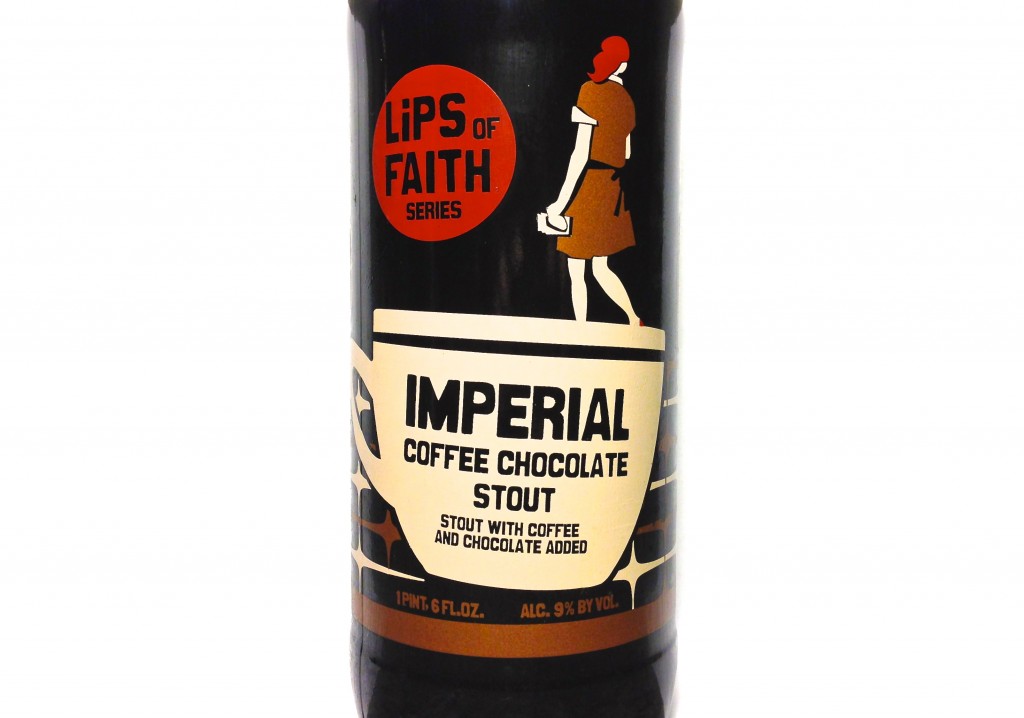 I’m convinced that this beer has some lactose in, as the smooth, creamy mouthfeel, and residual sweetness remind me of every other milk stout I’ve had. I’ve been told that there is no lactose in the beer, so I’m wondering if this sweet, creaminess may be coming from the chocolate in the beer. The coffee flavor is incredible. This beer really does taste like a black cup of coffee with some sweet creamer added. Again, I assume that this sweetness is coming from the chocolate, which, by the way, is perfectly balanced in this beer. Not over top, but some definite chocolate undertones present.
I’m convinced that this beer has some lactose in, as the smooth, creamy mouthfeel, and residual sweetness remind me of every other milk stout I’ve had. I’ve been told that there is no lactose in the beer, so I’m wondering if this sweet, creaminess may be coming from the chocolate in the beer. The coffee flavor is incredible. This beer really does taste like a black cup of coffee with some sweet creamer added. Again, I assume that this sweetness is coming from the chocolate, which, by the way, is perfectly balanced in this beer. Not over top, but some definite chocolate undertones present.
If you are a coffee lover, like myself, then I highly recommend you try this beer out. It is currently on tap at Khoury’s as well as Aces & Ales. Also pick up a bottle of Bièr De Garde while you’re at it!

Sour beers, while they may have more history than any other beer style, are quickly emerging to becoming quite the trend here in America. I’m going to take a quick moment to briefly explain what makes a beer sour, and describe some of the more common styles of sour beer.
Hopefully you’ve read my Science of Yeast articles. In the second article, I explained the chemical equation for the fermentation of sugar into carbon dioxide and ethanol. The third article ended by briefly explaining the existence of wild yeasts and bacterias that are sometimes used in beer production. To put the two together: while the Saccharomyces strain of yeast will consume sugar and turn it into alcohol, there are other microscopic organisms that will consume proteins and nutrients and turn them into acid, typically lactic acid. Lactic acid is sour, as you should know if you’ve ever eaten plain yogurt.
American breweries that are making sour beers are typically adding very specific bacterias into their beer to produce lactic acid. The most common bacterias used for this process would be Pediococcus Damnosus and Lactobacillus Delbruckii. While this makes for an exacting, and nearly reproducible, product, traditional sour beers were never made this way…
Traditional Belgian lambics are one of the most fascinating styles of beer. Rather than adding a single and sterile strain of bacteria, they simply let the beer ferment spontaneously. That is, once the beer is brewed, the hot wort is transferred to a coolship in the attic. A coolship is basically a large, shallow pan that is left wide open. The windows in the cobweb filled attic are also left wide open, to allow the Belgian air to pour in and cool the hot wort. The beer is then transferred off into barrels and left to ferment. While the beer was left exposed overnight in the coolship, as many as a few hundred different strains of yeast and bacteria enter into the beer. This collection of living organisms will ferment and acidify the beer over the next several years. Due to the cornucopia of yeasts and bugs that are added to coolships, very few American sour beers can even come close to the complexity of a Belgian lambic (however it is worth mentioning that there are a couple American breweries who also spontaneously ferment their beers).
Once the lambics are stored in barrels, the brewers will then age these beers for several years, occasionally offering different vintages for sale. The younger lambics have a sharp sourness to them. As they age, they stay sour, however they become balanced out with the other phenols and esters that are produced by the various yeasts present in the beer.
Guezue is the holy grail of sour beers. A gueuze is a beer made by blending one year, two year, and three year old lambics together. This creates a beer that not only features the sharp sourness of a fresh lambic, but also the smoothness of an aged lambic. Guezue is one of the most complex beers that I have ever tasted, with different layers of flavors present in each sip.
As I’m writing this, I’m drinking an Oude Gueuze Tilquin à I’Ancienne. The aroma is like smelling a grapefruit peel, with a bit of an added mustiness, and a slight wood like aroma. The initial up front flavor is mix of various citrus fruits, like grapefruit, lemon, and lime, but it then fades and reveals various other fruits as well. Fruits like green apples, and berries like tart cherry become more present towards the finish. The beer has a champagne like carbonation and it gives the beer a dry and crisp finish. The finish shows off it’s musty, barnyard like qualities that fade into a lingering sweetness that resembles the sweetness in an orange.

I fully admit that the first time you try a sour beer, you may not like it. It is difficult to prepare yourself for something like it. The first time I had New Belgium’s La Folie, I had a difficult time finishing it. Now I can’t get enough. Like most things in life, it is an acquired taste. However once you acquire it, you can never let it go! Gueuze, though hard to find in Las Vegas, are a good start since they are a bit balanced in their flavor. Jolly Pumpkin makes several approachable sour beers as well. Something like Bam Bière isn’t exactly sour, more so a little tart. This will start to build your tolerance and acceptance for acidity in beer. Work your way up to something like La Folie. It’s a deliciously complex beer, but it is intense in it’s sourness!








